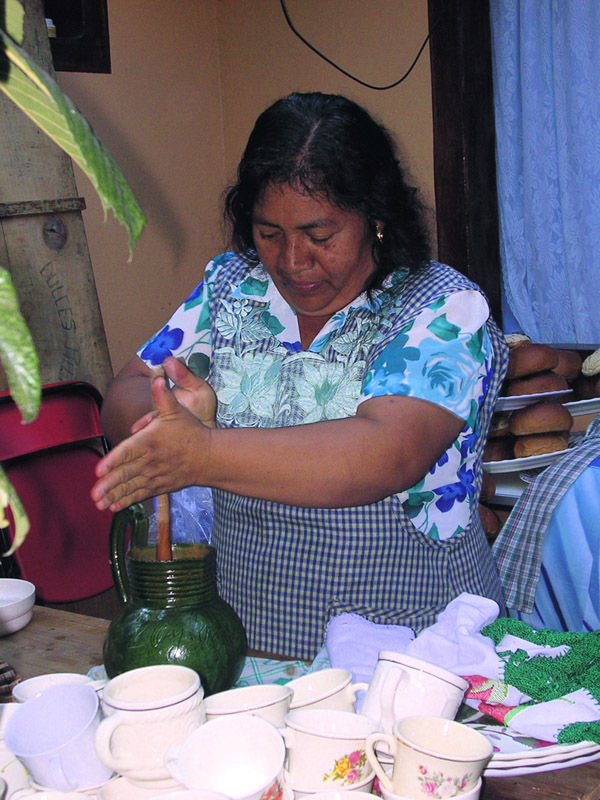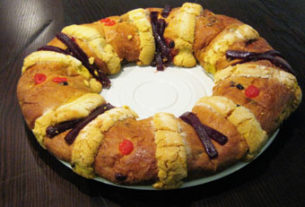Mexican Kitchen
Mexican chocolate refers to either the round, flat disks of cinnamon-scented chocolate found throughout the land, or the foamy drink made from them. This uniquely flavored sweet is popular in many other countries as well, and, along with flan and rompope, one of the more widely known Mexican dessert and beverage offerings.
For centuries, however, this was far from the case. Chocolate, perhaps the most popular of sweet foods, had a long history in Mesoamerica before the Europeans arrived, at which time it was neither sweet nor a food, but a beverage, and a sour one at that. Many years and outside influences were involved in its culinary evolution.

To begin with, the cacao tree, which yields the berries, or “beans”, that are the basis of chocolate, requires the moist heat of the tropics to flourish. Ethnobotanists may argue over whether the very first cacao trees appeared in Mexico, Central or South America, but they do agree that the processing and culinary use of theobroma cacao (“the gods’ food”) was first developed in what is now Mexico.
The word “cacao”, traced back to the Olmec inhabitants of Tabasco, Chiapas, Veracruz, and parts of Central America, was passed on to the lowland Maya, who succeeded them in this territory.
The Classic Maya, who flourished a full eight centuries before the Conquest, placed an obvious importance on chocolate, evident from the highly-adorned chocolate vessels, made of clay, that were entombed with them. Their descendents, who populated the Yucatan and other coastal areas when the Spanish arrived, were still using cacao beverages in rituals such as the wedding ceremony, where the bride and groom drank chocolate from a common goblet.
The use of chocolate as a beverage, a ritual offering, and even as a form of currency, was passed on from the Maya to the inhabitants of central Mexico, a high plateau which is too cool and dry for the cultivation of cacao. Its presence in this part of the country, which predates the Aztecs, was a result of trade with coastal regions. Teotihuacan, site of the great pyramids outside Mexico City, was a center of cacao trade, as was Cacaxtla, in the state of Puebla, where murals depicting Mayan cacao merchants can still be seen. But it was the Aztecs, who later came to dominate central Mexico, who took cacao to new heights of culinary, ritualistic, and monetary significance.
Cacao, for the Aztecs, symbolized the power and glory they attained in making the Valley of Mexico the seat of their vast empire. A yearly tribute of 980 loads of cacao, painstakingly counted out into 24,000 beans per load, provided the chocolate that topped off each of Moctezoma’s banquets, as well as that sold, with the addition of different flavorings, in Tenochtitlan’s many markets. The fact that cacao beans were used as currency, although of the smallest denomination, explains the careful counting. Cacao counterfeiting was not uncommon, with clay or packed earth used to fill the cacao shells.
The real cacao probably took more work to process than did the manufacture of the counterfeit version. The beans had to be fermented, cured and toasted, before being ground on the metate into the powder that was the basis for foamy chocolate drinks, called cacaoatl, Nahuatl for “cacao water.” (The theory that the word chocolate was derived from the sound – “choco, choco”- of the molinillo beating the liquid is unfounded, because such a utensil did not exist in Pre-hispanic Mexico; illustrations from the time show the foam being formed by pouring the beverage from one vessel to another.)
The drink was flavored with a great variety of other ingredients, among them, sesame seeds, anise seeds, vanilla, allspice, ground corn, honey and chiles. At the royal banquets, it was often served flavored with a variety of dried and powdered aromatic flowers. One of these, magnolia mexicana, was said to be a cure for sterility as well as a flavoring for chocolate, and it was this version of the drink that Moctezuma imbibed before visiting his wives.
Chocolate also played a part in the religious lives of the Aztecs, who gave the drink to human offerings, to bless the sacrifice. It is not clear whether they were influenced in this regard by the Maya, but it is known that the Maya sometimes added achiote, a dark red seasoning paste, to chocolate to produce a deep red color, which may indicate that the beverage was used as a substitute for the earlier blood sacrifices.
Although these religious rituals were roundly condemned by the Spaniards, they were quick to pick up on the chocolate habit, possibly because of the effects of the caffeine. Chocolate was the first stimulating beverage to be encountered by the Europeans, coffee and tea being introduced to them a century later. An Italian traveler to sixteenth-century Mexico, who brought chocolate back to Florence, describes the New World Spaniards as being “addicted” to it.
The Spanish royals who married into the French court were responsible for chocolate’s introduction to that country, and soon it was popular with a variety of Europeans, from French nobility to English pirates. The addition of sugar, cinnamon, eggs, almonds and vanilla to make the classic combination known as “Mexican chocolate” has been attributed both to chefs in Spain, and Spanish nuns in Puebla. Whichever is true, we do know that the formation and storage of this flavored chocolate as round tablets, the kind sold commercially today, was begun by the Spanish ladies of colonial Guatemala toward the end of the 1500’s. The recipe for making these tablets from scratch, starting with cacao beans, was published fifty years ago in the United States in a book called Good Food from Mexico which, although in English, was recently found by a friend in the Puebla flea market.
The following recipes all use this same kind of chocolate, sold in supermarkets in the US, Canada and Europe, usually under the brand name Ibarra, produced in Guadalajara, Jalisco, and distributed world-wide. These treats, while possibly not having the aphrodesiac effect of Moctezuma’s brew, are perfect for Valentine’s Day. One year I made an all-chocolate Valentine dinner for my husband, who is very fond of the sweet moles that use this chocolate. Whether or not you decide to serve mole, a dessert made with Mexican chocolate is a fine finish for any meal.
- Chocolate flan: Flan de chocolate
- Crepes with Mexican chocolate sauce: Crepas con chocolate
- Chocolate Floating Island: Sopa de Chocolate


